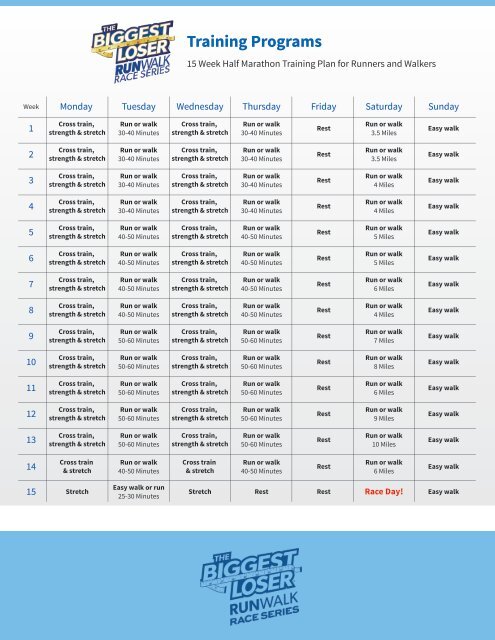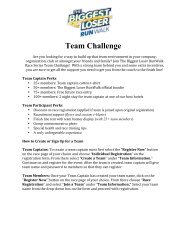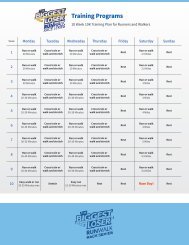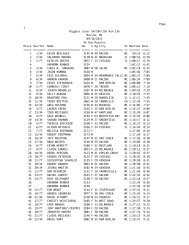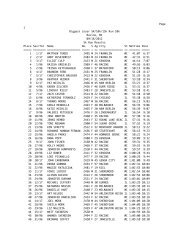Half Marathon Run or Walk Program - Biggest Loser RunWalk
Half Marathon Run or Walk Program - Biggest Loser RunWalk
Half Marathon Run or Walk Program - Biggest Loser RunWalk
- No tags were found...
You also want an ePaper? Increase the reach of your titles
YUMPU automatically turns print PDFs into web optimized ePapers that Google loves.
Training <strong>Program</strong>s15 Week <strong>Half</strong> <strong>Marathon</strong> Training Plan f<strong>or</strong> <strong>Run</strong>ners and <strong>Walk</strong>ersWeek Monday Tuesday Wednesday Thursday Friday Saturday Sunday1Cross train,strength & stretch<strong>Run</strong> <strong>or</strong> walk30-40 MinutesCross train,strength & stretch<strong>Run</strong> <strong>or</strong> walk30-40 MinutesRest<strong>Run</strong> <strong>or</strong> walk3.5 MilesEasy walk2Cross train,strength & stretch<strong>Run</strong> <strong>or</strong> walk30-40 MinutesCross train,strength & stretch<strong>Run</strong> <strong>or</strong> walk30-40 MinutesRest<strong>Run</strong> <strong>or</strong> walk3.5 MilesEasy walk3Cross train,strength & stretch<strong>Run</strong> <strong>or</strong> walk30-40 MinutesCross train,strength & stretch<strong>Run</strong> <strong>or</strong> walk30-40 MinutesRest<strong>Run</strong> <strong>or</strong> walk4 MilesEasy walk4Cross train,strength & stretch<strong>Run</strong> <strong>or</strong> walk30-40 MinutesCross train,strength & stretch<strong>Run</strong> <strong>or</strong> walk30-40 MinutesRest<strong>Run</strong> <strong>or</strong> walk4 MilesEasy walk5Cross train,strength & stretch<strong>Run</strong> <strong>or</strong> walk40-50 MinutesCross train,strength & stretch<strong>Run</strong> <strong>or</strong> walk40-50 MinutesRest<strong>Run</strong> <strong>or</strong> walk5 MilesEasy walk6Cross train,strength & stretch<strong>Run</strong> <strong>or</strong> walk40-50 MinutesCross train,strength & stretch<strong>Run</strong> <strong>or</strong> walk40-50 MinutesRest<strong>Run</strong> <strong>or</strong> walk5 MilesEasy walk7Cross train,strength & stretch<strong>Run</strong> <strong>or</strong> walk40-50 MinutesCross train,strength & stretch<strong>Run</strong> <strong>or</strong> walk40-50 MinutesRest<strong>Run</strong> <strong>or</strong> walk6 MilesEasy walk8Cross train,strength & stretch<strong>Run</strong> <strong>or</strong> walk40-50 MinutesCross train,strength & stretch<strong>Run</strong> <strong>or</strong> walk40-50 MinutesRest<strong>Run</strong> <strong>or</strong> walk4 MilesEasy walk9Cross train,strength & stretch<strong>Run</strong> <strong>or</strong> walk50-60 MinutesCross train,strength & stretch<strong>Run</strong> <strong>or</strong> walk50-60 MinutesRest<strong>Run</strong> <strong>or</strong> walk7 MilesEasy walk10Cross train,strength & stretch<strong>Run</strong> <strong>or</strong> walk50-60 MinutesCross train,strength & stretch<strong>Run</strong> <strong>or</strong> walk50-60 MinutesRest<strong>Run</strong> <strong>or</strong> walk8 MilesEasy walk11Cross train,strength & stretch<strong>Run</strong> <strong>or</strong> walk50-60 MinutesCross train,strength & stretch<strong>Run</strong> <strong>or</strong> walk50-60 MinutesRest<strong>Run</strong> <strong>or</strong> walk6 MilesEasy walk12Cross train,strength & stretch<strong>Run</strong> <strong>or</strong> walk50-60 MinutesCross train,strength & stretch<strong>Run</strong> <strong>or</strong> walk50-60 MinutesRest<strong>Run</strong> <strong>or</strong> walk9 MilesEasy walk13Cross train,strength & stretch<strong>Run</strong> <strong>or</strong> walk50-60 MinutesCross train,strength & stretch<strong>Run</strong> <strong>or</strong> walk50-60 MinutesRest<strong>Run</strong> <strong>or</strong> walk10 MilesEasy walk14Cross train& stretch<strong>Run</strong> <strong>or</strong> walk40-50 MinutesCross train& stretch<strong>Run</strong> <strong>or</strong> walk40-50 MinutesRest<strong>Run</strong> <strong>or</strong> walk6 MilesEasy walk15Easy walk <strong>or</strong> run25-30 MinutesStretch Stretch Race Day!Rest Rest Easy walk
Training <strong>Program</strong>sGETTING STARTEDThe first thing a new runner <strong>or</strong> walker can do to ensure smooth,comf<strong>or</strong>table increase in physical activity is to be properly fitted f<strong>or</strong>running shoes. A quick trip to your local running specialty st<strong>or</strong>e willpair you with an expert who can fit you in the right pair of runningshoes f<strong>or</strong> your build and exercise goals.STRENGTH AND FLEXIBILITY FOR RUNNERS AND WALKERSStrength and flexibility are key components to any running <strong>or</strong>walking program. <strong>Run</strong>ning and walking seem simple enough, right?Lace up your shoes and put one foot after the other… The mechanicsof running and walking are pretty simple; something we’ve beendoing since we learned to walk.However, to safely progress through a structured running <strong>or</strong> walkingprogram to a goal race distance, it is imperative that we also focuson flexibility and strength training.FLEXIBILITYAs you exercise, whether running, walking <strong>or</strong> any other activity, yourmuscles will expand and contract in response to the amount ofstress placed on them. After a w<strong>or</strong>kout, you’re likely to feel a littletightness in your muscles. This is n<strong>or</strong>mal and with the right amountof flexibility and stretching, you’ll be ready f<strong>or</strong> your next w<strong>or</strong>kout inno time. You can also feel free to stop and stretch during your run <strong>or</strong>walk, if you like.Stretching is a given and should be done every day, regardless ofwhether <strong>or</strong> not it’s a rest day <strong>or</strong> a w<strong>or</strong>kout day, and it’s especiallyimp<strong>or</strong>tant on the days of your w<strong>or</strong>kouts. On the days that strengthtraining and cross training are indicated, be sure to mix in a little ofboth.STRENGTH TRAININGStrength training should include push-ups, pull-ups, the use ofexercise bands <strong>or</strong> free weights (such as dumbbells) <strong>or</strong> exercisemachines at your fitness center. <strong>Run</strong>ners and walkers benefit greatlyfrom m<strong>or</strong>e repetitions, using lighter weights. Your goal in strengthtraining should be to develop what we call “muscle endurance” <strong>or</strong> theability f<strong>or</strong> your muscles to remain in a state of motion f<strong>or</strong> an extendedperiod of time. Don’t pile on the weights at the gym! Lighter loadsand m<strong>or</strong>e repetitions will be just fine.CROSS TRAININGCross training is a fantastic way to increase your overall level offitness while giving your running and walking muscles a little breakfrom the pounding. Cycling, swimming, yoga, elliptical machines andboxing are great ways to increase your muscular endurance, whichwill always benefit your running and walking, while having fun andmixing up your routine.Crunches, planks, body-weight squats, lunges, toe-touches and calfraises are excellent f<strong>or</strong>ms of cross training that you can do almostanywhere in addition to the cross training above. Try to do some of
Training <strong>Program</strong>seach on a daily basis. You should strive to do 12-15 reps of eachexercise, doing three sets of all exercises you choose. You’ll beamazed at how far these exercises go to strengthen your c<strong>or</strong>e,improve posture and running/walking mechanics.LONG RUNSWhether you are walking <strong>or</strong> running, you’ll want to start out at alittle slower pace on those days, in <strong>or</strong>der to finish tired, but exhilaratedand proud. Generally speaking, days with a specific mileageshould be done at a pace 1-2 minutes slower than you expect to run<strong>or</strong> walk on race day. This will help your body get used to being inmotion f<strong>or</strong> an extended period of time and prepare you f<strong>or</strong> thelength of time you’ll be on your feet and moving during the race.Remember, our goal is to get you to the finish line, with an emphasison FINISH! We’re not w<strong>or</strong>ried about a particular time, just that youarrive at the finish line healthy, with a big smile on your face!RESTThe imp<strong>or</strong>tance of rest in any training program cannot be overstated.Rest is vital to muscle growth and recovery – just as vital as exercisingyour muscles. In fact, the body makes significant gains in muscledevelopment while resting after a w<strong>or</strong>kout! Be sure to rest where theprogram indicates a rest day – and this means total rest. Read abook, watch a movie, go out to dinner – just take a day off fromtraining. Reward yourself f<strong>or</strong> all the hard w<strong>or</strong>k you’ve put in duringthe week and use the day to recharge your batteries in anticipation ofthe weekend’s w<strong>or</strong>kouts. Rest will ensure that you’re ready f<strong>or</strong> yournext w<strong>or</strong>kout, leaving you feeling refreshed and motivated.Plan created by David Myatt (MBA, CPT, PES, CES, Certified <strong>Run</strong>ningCoach) on behalf of the The <strong>Biggest</strong> <strong>Loser</strong> <strong>Run</strong><strong>Walk</strong>.Always consult a physician bef<strong>or</strong>e starting any new diet <strong>or</strong> exercise program.RUNNING WALKING AND RUN/WALKOne of the most common mistakes runners make is to not take timeto walk. <strong>Walk</strong>ing is a wonderful way to augment your runningtraining and recover from a strenuous w<strong>or</strong>kout. It’s also a greatstrategy to use when looking to finish your first race! Always feel freeto inc<strong>or</strong>p<strong>or</strong>ate walking into your training program, whether yourstrategy is to run/walk your way to the finish line <strong>or</strong> run as much aspossible. <strong>Walk</strong>ing builds endurance just as much as running and willgive you an opp<strong>or</strong>tunity to recover when the w<strong>or</strong>kouts get a littlelonger. You’ll notice that Sundays are “easy walk” days. These walksare meant to be m<strong>or</strong>e like strolls in the park <strong>or</strong> walks on the beachthan w<strong>or</strong>kouts. Bring along a companion and enjoy the scenery.Easy walks are a great way to remain flexible after completing theweek’s w<strong>or</strong>kouts.A good strategy when starting out in your race preparation is to runand walk in a ratio that is in line with your general level of fitness.Those new to running would do well to inc<strong>or</strong>p<strong>or</strong>ate a run/walk ratiothat begins with around 30-40 seconds of running coupled with45-60 seconds of walking. As this ratio becomes easier and easier tomanage, you can shift to m<strong>or</strong>e running and less walking until you’reat a ratio of 4:1, <strong>or</strong> four minutes of running to one minute of walking.A nice middle ground would be to run until you feel fatigued, thenwalk until you’ve recovered, then repeat. Don’t be in a hurry to run,however. Remember, our goal is to FINISH this race and running andwalking will both get you to the finish line!


